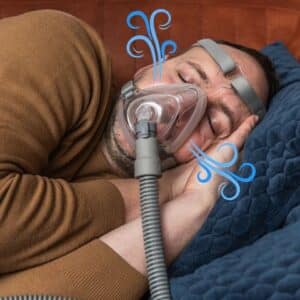
Using a CPAP machine can transform life for someone with obstructive sleep apnea, but many users face CPAP troubles that go beyond the familiar issue of mask leaks. Identifying and fixing these problems early ensures therapy stays effective and comfortable. Below are common issues—beyond mere air leaks—and practical solutions.
Dry Mouth, Throat Irritation & Nasal Congestion
One of the most frequent complaints among CPAP users is waking with a dry mouth or sore throat. This often happens when the user breathes through the mouth during sleep while using a nasal or nasal-pillow mask. The pressurized air escapes through the open mouth, drying mucous membranes.
Another issue is nasal congestion or a runny nose. Pressurized airflow can irritate nasal passages, especially when humidity is insufficient. Drying and irritation may even trigger nosebleeds.
What to try:
- Use or adjust the built-in heated humidifier in the CPAP device to add moisture.
- If mouth breathing is the culprit, consider a chin strap to hold your jaw closed or switch to a full-face mask.
- Rinse nasal passages with saline spray before sleep.
- Ensure your mask fits well (not too tight or loose) so that leaks don’t exacerbate dryness.
Pressure Discomfort and Difficulty Exhaling
Some users feel discomfort or struggle to breathe out against the continuous positive pressure. This can cause a feeling of “pushing air” into the lungs or chest tightness.
What to try:
- Use or ask your clinician to adjust the ramp feature, which starts pressure lower and then gradually increases.
- Explore machines with pressure relief on exhale (some call it EPR, C-Flex, or similar).
- If persistent, talk to your sleep specialist about switching to a BiPAP (Bi-level PAP) or APAP mode, which provides variable pressure for inhale and exhale
Aerophagia: Swallowed Air & Bloating
A less obvious but still common CPAP trouble is aerophagia—when excess air enters the stomach instead of the airway, causing burping, bloating, and discomfort.
What to try:
- Lower the pressure (under expert guidance) if set too high.
- Use a mask type better matched to your breathing habits—mouth breathers may do better with full-face masks.
- Avoid swallowing or gulping air by relaxing your breathing pattern at sleep onset.
- If it continues, your clinician may help adjust settings or mask.
Mask Discomfort, Skin Irritation & Claustrophobia
Many users report discomfort, red marks, or feelings of claustrophobia when wearing their mask.
What to try:
- Ensure proper mask size and fit. Even slight misalignment can create pressure spots.
- Adjust headgear straps evenly; avoid overtightening.
- Try masks with minimal coverage (e.g. nasal pillows) if full masks feel confining.
- Practice wearing the mask during waking hours to desensitize.
Noisy Machine, Power & Hardware Issues
Sometimes CPAP troubles stem from the device itself rather than the mask or user. Users may notice excessive noise, weak pressure, or even failure to start.
What to try:
- Confirm the power cord is properly connected, and the outlet works
- Clean or replace clogged filters (dirty filters make the motor work harder)
- Inspect the tubing for cracks, holes, or loose connections.
- Move the machine slightly farther from the bed to reduce noise impact.
- If the motor is aging or defective, consult the provider for repair or replacement.
Miscellaneous Issues: Eye Irritation, Mask Removal, & Compliance
- Dry or irritated eyes may signal mask leaks near the nasal bridge or eyes. Adjust fit or replace the mask.
- Some users unconsciously remove the mask during sleep due to discomfort or habit. A better fitting mask or more flexible headgear can reduce this.
- Poor adherence or compliance is often rooted in discomfort or unaddressed side issues. Psychological support, coaching, and close follow-ups can help.
Final Thoughts & Tips
When you encounter CPAP troubles, don’t give up at the first hurdle. Many of these problems have manageable fixes. Keep a journal of symptoms—when they occur, how you slept, changes you made—and review it with your sleep specialist. Adjusting humidity, pressure settings, mask style, or swapping parts often resolve these issues.
